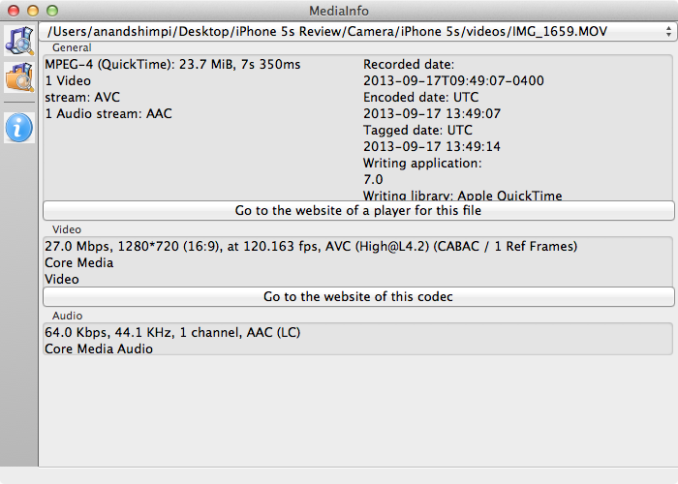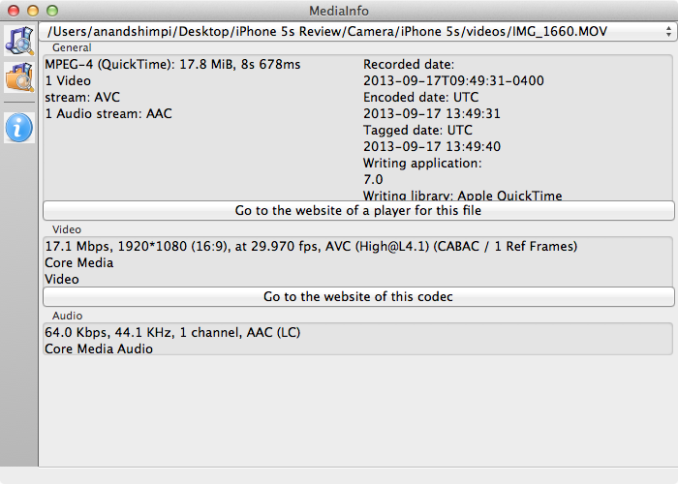The iPhone 5s Review
by Anand Lal Shimpi on September 17, 2013 9:01 PM EST- Posted in
- Smartphones
- Apple
- Mobile
- iPhone
- iPhone 5S
Video
Apple’s new H6 ISP brings with it a modernization of the video recording options for the iPhone 5s. The default video record mode is still 1080p at 30 fps, but there’s also a new 720p 120 fps “slo-mo” mode as well. In the latter, video is captured at 120 fps but optionally played back at 30 fps in order to achieve a high speed camera/slow motion effect. The result is pretty cool:
In the camera UI you can select what portions of the video you want to play back at 30 fps and what portions you want to leave at full speed. The .mov file is stored on NAND as a ~27Mbps 720p120 without any customizations, however when you share it the entire video is transcoded into a 30 fps format which preserves the slow motion effect.
The slo-mo mode is separate from the standard video recording mode, it’s the next stop on the dial in the new iOS 7 camera app. Video preview in slo-mo mode also happens at 60 fps compared to 30 fps for the standard video record and still image capture modes.
 Camera preview frame rate, toggling between slo-mo and normal modes
Camera preview frame rate, toggling between slo-mo and normal modes
Adding high speed camera modes to smartphones is a great step in my opinion and a wonderful use of increases in ISP and SoC performance. I would like to see Apple expose a 1080p60 mode as well. Technically 1080p60 does require slightly more bandwidth than 720p120, but I’d hope that Apple targeted both in the design of H6 and simply chose to expose 720p120 as it’s an easier feature to market.
Standard 1080p30 recording is also available:













464 Comments
View All Comments
akdj - Friday, September 27, 2013 - link
I completely agree---that said, we're really only 5 years 'in'. The original iPhone in '07, a true Android follow up in late '07/early '08---those were crap. Not really necessary to 'bench' them. We all kinda knew the performance we could expect, same for the next generation or two. In the past three years---Moore's law has swung in to high gear, these are now---literally---replacement computers (along with tablets) for the majority of the population. They're not using their home desktop anymore for email, Facebook, surfing and recipes. Even gaming---unless their @ 'work' and in front of their 'work Dell' from 2006, they're on their smartphones...for literally everything! In these past three years---and it seems Anand, Brian and crew are quite 'up front' about the lack of mobile testing applications and software----we're in it's infancy. 36 real months in with software, hardware and OS'es worth 'testing, benchmarking, and measuring' their performance. Just my opinion....and I suppose we're saying the same thing.That said---even Google's new Octane test was and is being used lately---GeekBench has revised their software, it's coming is my point. But just looking at those differences in the generations of iPhones makes it blatantly obvious how far we've come in 4/5 short years. In 2008 and 9---these were still phones with easier ways to text and access the internet, some cool apps and ways to take, manipulate and share pics and videos. Today----they do literally everything an actual computer does and I'd bet---in a lot of cases, these phones are as or more powerful, faster and more acessible than those ancient beige boxes from the mid 2000s a lot of folks have in their home office;)
Duck <(' ) - Thursday, October 3, 2013 - link
they are posting false benchmark scores. Same phones score different in youtube vids.iPhone 5 browsermark 2 score is around 2300
check here https://www.youtube.com/watch?v=iATFnXociC4
sgs4 scores 2745 here https://www.youtube.com/watch?v=PdNE4NoFq8U
ddriver - Wednesday, September 18, 2013 - link
Actually, there are quite a lot of discrepancies in this review.For starters, the "CPU performance" page only contains JS benchmarks and not a single native application. And iOS and Android use entirely different JS engines, so this is literally a case of comparing apples to oranges.
Native benchmarks don't compare the new apple chip to "old 32 bit v7 chips" - it only compares the new apple chip to the old ones, and also compares the new chip in 32bit and 64 bit mode. Oddly enough, the geekbench at engadget shows tegra 4 actually being faster.
Then, there is the inclusion of hardware implementation in charts that are supposed to show the benefits of 64bit execution mode, but in reality the encryption workloads are handled in a fundamentally different way in the two modes, in software in 32bit mode and implemented in hardware in 64bit mode. This turns the integer performance chart from a mixed bad into one falsely advertising performance gains attributed to 64bit execution and not to the hardware implementations as it should. The FP chart also shows no miracles, wider SIMD units result in almost 2x the score in few tests, nothing much in the rest.
All in all, I'd say this is a very cleverly compiled review, cunningly deceitful to show the new apple chip in a much better light than it is in reality. No surprises, considering this is AT, it would be more unexpected to see an unbiased review.
I guess we will have to wait a bit more until mass availability for unbiased reviews, considering all those "featured" reviews usually come with careful guidelines by the manufacturer that need to be followed to create an unrealistically good presentation of the product. That is the price you have to pay to get the new goodies first - play by the rules of a greedy and exploitative industry. Corporate "honesty" :)
I don't say the new chip is bad, I just say it is deliberately presented unrealistically good. Krait has expanded the SIMD units to 128 bit as well, so we should see similar performance even without the move to a 64bit ecosystem. Last but not least, 64bit code bloats the memory footprint of applications because of pointers being twice as big, and while those limited memory footprint synthetic benches play well with the single gigabyte of ram on this device, I expect an actual performance demanding real world application will be bottlenecked by the ram capacity. All in all, the decision to go for 64 bit architecture is mostly a PR stunt, surely, 64bit is the future, but in the case of this product, and considering its limited ram capacity, it doesn't really make all that sense, but is something that will no doubt keep up the spirit of apple fanboys, and make up for their declining sales while they bring out the iphone 6, which will close all those deliberately left gaping holes in the 5s.
Slaanesh - Wednesday, September 18, 2013 - link
Interesting comment. I'd like to know what Anand has to say about this.ddriver - Wednesday, September 18, 2013 - link
I am betting my comment will most likely vanish mysteriously. I'd be happy to see my concerns addressed though, but I admit I am putting Anand in a very inconvenient position.Mondozai - Wednesday, September 18, 2013 - link
It's all a conspiracy. In fact your comment has already disappeared, but in its place is now a hologram effect that makes it impossible to tell it from the blank space. So why put in the hologram and not just delete it? Because Anand is playing mind games with us.And who said I typed this comment? It could have been someone else, someone doing Anand's bidding.
I admit I am putting his scheme of deception in a very difficult position right now.
/s
ddriver - Wednesday, September 18, 2013 - link
Few days ago I posted a comment criticizing AT moderators being idle and tolerant of the "I make $$$ sitting in front of my mac" spam, few minutes later my comment was removed while the spam remained, which led me to expect similar fate for this comment. Good thing I was wrong ;)WardenOfBats - Wednesday, September 18, 2013 - link
I'd honestly like to see your misleading comment removed as well. You seem to think that anyone cares what the 32bit performance is of the 5S when everyone knows damn well that app developers are going to be clamouring to switch to the 64bit tech (that Android doesn't even have or support) to get these power increases. Other than that, the rest of your comment is just nonsense. The whole point is that the iPhone 5S is faster and the fact that they use different JS engines is a part of that. Apple just knows how to make software optimizations and hardware that runs them faster and you can see how they just blow the competition away.CyberAngel - Thursday, September 19, 2013 - link
Misleading? Yes! In favor of Apple!You need to double the memory lines, too and caches and...oh boy!
The next Apple CPU will be "corrected" and THEN we'll see...hopefully RAM is 8GB...
Ryan Smith - Thursday, September 19, 2013 - link
As we often have to remind people, we don't delete comments unless they're spam. However when we do so, any child comments become orphaned and lose their place in the hierarchy, becoming posts at the end of the thread. Your comment isn't going anywhere, nor have any of your previous comments.